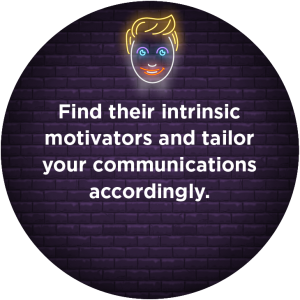This year’s Gatehouse State of the Sector report makes grim reading when it comes to line manager communication.
While only a quarter of internal communicators view managers’ communication skills positively, even fewer plan to tackle the issue in 2019.
‘We’ve surrendered the battle against poor line manager communication,’ the authors conclude.
So what stops managers becoming great communicators? Time? Every line manager has competing demands on their time, so devoting extra resources to communication may feel impossible. Confidence may also be an issue. If they don’t have a great relationship with their team, they’ll feel like that child raiding the spare kit cupboard before cross country.
Fortunately, there are simple ways to tackle both these issues, which you can use either with line managers or with your own team. They may not be rocket science, but together they can reap big rewards.
Smile
Smiling may seem trivial, but this seemingly humble gesture has science in its corner.
Research shows that making a conscious effort to smile not only makes you feel better, it improves the mood of others too. Colleagues ‘catch’ the mood of their leaders: if those emotions are positive, they’re more likely to perform well.
But what if you’re not feeling positive? Try smiling for around 15 seconds. Studies suggest it tricks your brain into releasing neurochemicals that actually do make you feel happier.
Say hello in the morning
Greeting your team in the morning shows you’re visible, approachable and open to conversation. But it’s surprising how many managers don’t make the effort to do this.
Taking an interest in what your team members did at the weekend or finding out what they do outside work takes little investment, but builds relationships rapidly.
If your team is more dispersed, schedule frequent times to check in and say hello.
Introduce senior leaders to your team members
One easy way to make your team feel valued is to introduce them to senior leaders whenever the opportunity arises.
If senior leaders visit your site, ask them to walk round so you can introduce them. You could also ask them to comment on any recent team successes. Not only does this make your team feel more important, it also makes your leaders seem more human and approachable.
Discover your team’s motivators
Everyone finds intrinsic motivators in their role. They may like a company’s products, purpose or stature. They may like the work itself. They may feel a sense of belonging, or the reward of helping others.
If you work in a fast food restaurant, for example, you’re more likely to be motivated by the fun of working with like-minded colleagues than by the challenge of creating the perfect burger.
As Bob Matha and Macy Boehm point out in Beyond the Babble, if we know our team’s motivators we can tailor our communications accordingly. And if you don’t know, just ask them: ‘what do you like most about working here?’
Create a huddle board
Huddles are an effective way to improve communication with your teams. You can take them a step further with a huddle board.
Simply put a noticeboard in a communal area and ask your team to add post-its with questions, ideas or agenda items. Then go through them in your next huddle. You can also use the board to add a brief summary for colleagues who couldn’t attend.
If your team work remotely try setting up something similar using online tools.
Ask open-ended questions
It’s disheartening to be greeted with silence when asking if anyone has questions. But closed questions like this discourage input.
It’s more effective to ask open-ended questions that encourage colleagues to offer personal opinions on specific issues. What’s your view on that? How do you feel that relates to our team? What concerns do you have about this week?
Ask for advice
Some managers feel they should know all the answers, and act accordingly. But this can have a negative effect on their team, stifling engagement, innovation and creativity by implying team members have little to offer.
One simple way to change this perception is to ask individual team members for advice. It doesn’t even have to be about work: ask for advice on your travel plans or which smartphone to buy. Asking for advice shows you don’t have all the answers, and that you value your team’s knowledge and opinions.
Take responsibility
Everyone makes mistakes, but failing to take responsibility quickly erodes trust. Unfortunately, our brains tend to conspire against us. Studies show we often reconstruct the narrative of negative events to place us in a better light.
But admitting a mistake can strengthen our standing. President Kennedy’s popularity soared after he acknowledged his culpability for the disastrous Bay of Pigs invasion in 1961. ‘This administration intends to be candid about its errors,’ he pronounced, adding that responsibility for the failed mission was ‘mine, and mine alone.’
Acknowledge personal events
Some organisations are hot on recognising their employees’ personal milestones, and with good reason. Acknowledging birthdays, weddings, births or bereavements makes a statement: ‘we recognise you as a person, not just as an employee’.
It’s easy to find out your team members’ birthdays and give them a card, or buy them a coffee. But the impact is significant.
Ask for feedback
Take a minute at the end of a one-to-one meeting to ask a team member if there’s anything they need from you, or would like you to do differently.
Asking for feedback sends a clear message: you want to help them deliver, and you’re open to improvement.
Simple engagement tactics like these can help managers build deeper trust and stronger relationships with their teams, and make them better communicators. So perhaps it’s not time to throw in the towel on poor line manager communication just yet…
By Dave Wraith for Alive!
















